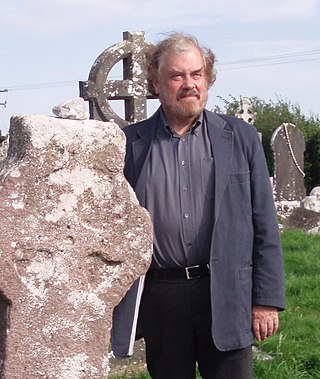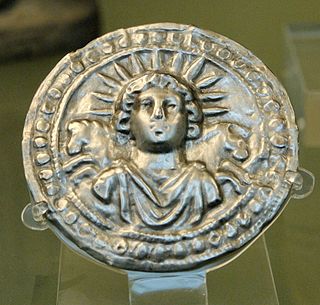Related Research Articles

The Celts or Celtic peoples were a collection of Indo-European peoples in Europe and Anatolia, identified by their use of Celtic languages and other cultural similarities. Major Celtic groups included the Gauls; the Celtiberians and Gallaeci of Iberia; the Britons, Picts, and Gaels of Britain and Ireland; the Boii; and the Galatians. The relation between ethnicity, language and culture in the Celtic world is unclear and debated; for example over the ways in which the Iron Age people of Britain and Ireland should be called Celts. In current scholarship, 'Celt' primarily refers to 'speakers of Celtic languages' rather than to a single ethnic group.

Gaul was a region of Western Europe first clearly described by the Romans, encompassing present-day France, Belgium, Luxembourg, and parts of Switzerland, the Netherlands, Germany, and Northern Italy. It covered an area of 494,000 km2 (191,000 sq mi). According to Julius Caesar, who took control of the region on behalf of the Roman Republic, Gaul was divided into three parts: Gallia Celtica, Belgica, and Aquitania.

In Gallo-Roman religion, Epona was a protector of horses, ponies, donkeys, and mules. She was particularly a goddess of fertility, as shown by her attributes of a patera, cornucopia, ears of grain, and the presence of foals in some sculptures. She and her horses might also have been leaders of the soul in the after-life ride, with later literary parallels in Rhiannon of the Mabinogion. The worship of Epona, "the sole Celtic divinity ultimately worshipped in Rome itself", as the patroness of cavalry, was widespread in the Roman Empire between the first and third centuries AD; this is unusual for a Celtic deity, most of whom were associated with specific localities.

Abnoba is a name with theological and geographical meanings: It is the name of a Gaulish goddess who was worshiped in the Black Forest and surrounding areas. It is also the name of a mountain or mountain range.

Erecura or Aerecura was a goddess worshipped in ancient times, often thought to be Celtic in origin, mostly represented with the attributes of Proserpina and associated with the Roman underworld god Dis Pater, as on an altar from Sulzbach. She appears with Dis Pater in a statue found at Oberseebach, Switzerland, and in several magical texts from Austria, once in the company of Cerberus and once probably with Ogmios. A further inscription to her has been found near Stuttgart, Germany. Besides her chthonic symbols, she is often depicted with such attributes of fertility as the cornucopia and apple baskets. She is believed to be similar to Greek Hecate, while the two goddesses share similar names. She is depicted in a seated posture, wearing a full robe and bearing trays or baskets of fruit, in depictions from Cannstatt and Sulzbach. Miranda Green calls Aericura a "Gaulish Hecuba", while Noémie Beck characterizes her as a "land-goddess" sharing both underworld and fertility aspects with Dis Pater.
In Welsh mythology, Amaethon was the god of agriculture, and the son of the goddess Dôn. His name means "labourer" or "ploughman", and he is cited as being responsible for the Cad Goddeu, or "Battle of Trees", between the lord of the otherworld, Arawn, and the Children of Dôn.

A wicker man was purportedly a large wicker statue in which the druids sacrificed humans and animals by burning. The main evidence for this practice is a sentence by Roman general Julius Caesar in his Commentary on the Gallic War, which modern scholarship has linked to an earlier Greek writer, Posidonius.

Pan-Celticism, also known as Celticism or Celtic nationalism is a political, social and cultural movement advocating solidarity and cooperation between Celtic nations and the modern Celts in Northwestern Europe. Some pan-Celtic organisations advocate the Celtic nations seceding from the United Kingdom and France and forming their own separate federal state together, while others simply advocate very close cooperation between independent sovereign Celtic nations, in the form of Breton, Cornish, Irish, Manx, Scottish, and Welsh nationalism.

In modern English, the nouns vates and ovate (, ), are used as technical terms for ancient Celtic bards, prophets and philosophers. The terms correspond to a Proto-Celtic word which can be reconstructed as *wātis. They are sometimes also used as English equivalents to later Celtic terms such as Irish fáith "prophet, seer".

Ancient Celtic religion, commonly known as Celtic paganism, was the religion of the ancient Celtic peoples of Europe. Because there are no extant native records of their beliefs, evidence about their religion is gleaned from archaeology, Greco-Roman accounts, and literature from the early Christian period. Celtic paganism was one of a larger group of polytheistic Indo-European religions of Iron Age Europe.

Rhodogune was a queen of the Seleucid Empire by marriage to Demetrius II Nicator. She was the daughter of the Parthian king Mithridates I, and sister of Phraates II.

Peter Berresford Ellis is a British historian, literary biographer, and novelist who has published over 98 books to date either under his own name or his pseudonyms Peter Tremayne and Peter MacAlan. He has also published 100 short stories. Under Peter Tremayne, he is the author of the international bestselling Sister Fidelma historical mystery series. His work has appeared in 25 languages.
Terry Jones' Barbarians is a 4-part TV documentary series first broadcast on BBC 2 in 2006. It was written and presented by Terry Jones, and it challenges the received Roman and Roman Catholic notion of the barbarian.

Nora Kershaw Chadwick CBE FSA FBA was an English philologist who specialized in Anglo-Saxon, Celtic and Old Norse studies.

Tolistobogii is the name used by the Roman historian, Livy, for one of the three ancient Gallic tribes of Galatia in central Asia Minor, together with the Trocmi and Tectosages. The tribe entered Anatolia in 279 BC as a contingent of Celtic raiders from the Danube region, and settled in those regions of Phrygia which would later become part of the Roman province of Galatia. The Galatians retained their Celtic language through the 4th century AD, when Saint Jerome mentions that the Galatians still spoke a Celtic language in his times.
Pamphile or Pamphila of Epidaurus was a historian of Egyptian descent who lived in Greece during the reign of the Roman emperor Nero and wrote in Greek. She was the first known female Greco-Roman historian and, along with Ban Zhao, one of the first known female historians. She is best known for her lost Historical Commentaries, a collection of miscellaneous historical anecdotes in thirty-three books, which is frequently cited by the Roman writer Aulus Gellius in his Attic Nights and by the Greek biographer Diogenes Laërtius in his Lives and Opinions of Eminent Philosophers. She is also described in the tenth-century Byzantine encyclopedia, the Suda, and by the Byzantine writer Photios. According to the Suda, she wrote a large number of epitomes of the works of other historians as well as treatises on disputes and sex. She may be the author of the anonymous surviving Greek treatise Tractatus de mulieribus claris in bello, which gives brief biographical accounts of the lives of famous women.
This is a listing of published works by the historian and novelist Peter Berresford Ellis.

The appearance of Celts in Western Romania can be traced to the later La Tène period . Excavation of the great La Tène necropolis at Apahida, Cluj County, by S. Kovacs at the turn of the 20th century revealed the first evidence of Celtic culture in Romania. The 3rd–2nd century BC site is remarkable for its cremation burials and chiefly wheel-made funeral vessels.

Spargapises was the son of queen Tomyris of the Massagetai.
Tractatus de mulieribus claris in bello is a short ancient Greek work by an anonymous author, which discusses fourteen famous ancient women, of whom one is not otherwise attested. Despite the title, not all of the women discussed are warriors, and only a few are portrayed as skilled military strategists. It was written near the end of the second or the beginning of the first century BCE. Deborah Gera has suggested, however, that it was written by Pamphile of Epidaurus during the 1st century AD.
References
- ↑ Freeman, Philip (2006). The Philosopher and the Druids: A Journey Among the Ancient Celts. New York: Simon and Schuster. p. 206. ISBN 0-7432-8906-4.
- 1 2 Freedman, Phillip (2006). The Philosopher and the Druids: A Journey Among the Ancient Celts. New York, NY: Simon & Schuster. pp. 115–116. ISBN 0-7432-8906-4.
- 1 2 Koch, John (2006). Celtic Culture: A-Celti, Volume I. Santa Barbara, CA: ABC-CLIO. p. 1396. ISBN 1-85109-440-7.
- ↑ Rankin, H. D. (1996). Celts and the classical world. London. ISBN 0-203-27860-7. OCLC 52059285.
{{cite book}}: CS1 maint: location missing publisher (link) - 1 2 Gera, Deborah (1997). Warrior Women: The Anonymous Tractatus De Mulieribus. E.J. Brill, Leiden, the Netherlands. p. 10-11. ISBN 90-04-10665-0.
- ↑ Kazakevych, Gennadii (2021-12-30). "Horse-Rider Image on the Coins of the Eastern Celts and the Cult of Celtic War Goddess". The Ukrainian Numismatic Annual (5): 81–92. doi: 10.31470/2616-6275-2021-5-81-92 . ISSN 2616-6275. S2CID 245600751.
- ↑ Gera, Deborah (2018). Warrior Women: The Anonymous Tractatus De Mulieribus. Leiden: BRILL. p. 220. ISBN 978-90-04-32988-1.
- ↑ Celtic culture: a historical encyclopedia. Vol. 1-, Volume 2 edited by John T. Koch, p.1396
- ↑ Ereira, Alan; Jones, Terry (2009-05-27). Terry Jones' Barbarians - Alan Ereira, Terry Jones. Random House. ISBN 9781409070429 . Retrieved 2015-07-10.
- ↑ Ellis, Peter Berresford (1943-03-10). Celt and Greek: Celts in the Hellenic World - Peter Berresford Ellis. Constable. ISBN 9780094755802 . Retrieved 2015-07-10.
- ↑ Ellis, Peter Berresford (1943-03-10). Celtic women: women in Celtic society and literature - Peter Berresford Ellis. William B. Eerdmans Publishing Company. ISBN 9780802838087 . Retrieved 2015-07-10.